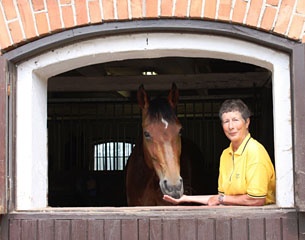
When she first appeared in an international dressage arena Josef Neckermann, Dr. Reiner Klimke, Elena Petushkova, and Henri Chammartin among many other eternal legends of dressage history were still in their prime.
The discussions at the time were not so much about abuse caused by certain training methods, but about the German or the Russian school in dressage and which should be preferred.
A renowned Swedish horseman named Gustav Nyblaeus was one of the most respected dressage judges on the scene and Swedish bred dressage horses were the money-spinners to such an extent that even the Germans were looking for prospects in Scandinavia.
The end of the 1960s marked the beginning of a woman’s career which now spans more than four decades. This person, who after some more quiet years, is back in the limelight with one of her most talented horses ever is Swedish dressage legend Ulla Hakanson.
With a remarkable career behind her and gifted with a remarkable personality Ulla is a living legend of dressage and still going strong at an age at which former colleagues have retired for long.
Horses from early on
 Ulla was born on 9 November 1937 in the Swedish town of Motala in the Östergotland region as one of two daughters of a cavalry officer.
Ulla was born on 9 November 1937 in the Swedish town of Motala in the Östergotland region as one of two daughters of a cavalry officer.
Ulla’s father served at the famous Swedish cavalry school of Strömsholm and the family always had horses of their own.
Not surprisingly he soon provided his two young girls, Ulla and her younger sister Marianne, with their first pony “Felix”. And like so often the pony wasn’t one of the most obedient creatures: “He was quite wild, but my father supported us with handling him. We also had a little carriage for Felix and drove with him just for fun.”
As a 13-year old Ulla debuted in her very first competition with the rascal. She did two classes, one in jumping and one in dressage. This was an omen as she couldn’t have foreseen that it would be exactly those disciplines at which Ulla would become an international rider approximately twenty years later.
In the 1950s, when Ulla was a teenage girl, Sweden turned out to be an extremely successful country at the equestrian Olympic Games. Members of the military won gold in the team and individual sections in both dressage and 3-day eventing; it was a glorious and inspiring time for a horse-mad girl.
After the family’s move to the Stockholm area she even won her first show jumping class. After riding new as well as riding club horses for three years Ulla’s father bought her a Swedish warmblood when she was 16.
It was the first of several horses getting a name ending with the letter “x” “because my father told me that horses are listening extremely well when they names with an x at the end.” With Strix and Max Ulla enjoyed much success in jumping classes until the end of the 1950s. Being barely 20 she had ridden and trained more different horses than many of her peers which gave her an edge and a valuable basis for an equestrian career to come.
Moreover she wasn’t one of these girls driving over fences, using the legs as a gas-pedal and the reins as brakes, instead Ulla’s father had always taught her the importance of dressage work as the vital basis for any kind of equitation.
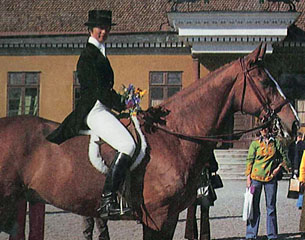 In 1962 Ulla’s focus was still strongly on jumping when her father bought the young Swedish chestnut Ajax, which would years later transform her into a dressage rider and which launched her international career in both disciplines.
In 1962 Ulla’s focus was still strongly on jumping when her father bought the young Swedish chestnut Ajax, which would years later transform her into a dressage rider and which launched her international career in both disciplines.
Though Ulla’s father had stamped his daughter’s approach to horses by letting her ride from an early age, Ulla is now mainly trained by her husband Arne, who is a member of the cavalry and a jumping rider whom she had married in 1962.
“Like my father my husband also considered dressage training as very important for a jumping horse so all our horses, which we had stabled in the military barracks back then, got specialised dressage training as well. For example we taught all of them the piaffe to engage the hind legs and make them more flexible and of course all could do flying changes, essential when one has to change direction in a course,” Ulla explained.
Not all of their jumpers were shown in dressage competitions and even though “Ajax was more talented for jumping from the beginning” the chestnut was also started successfully in dressage up to M- level. He became so successful that only two years later he wasn't allowed to start at this level anymore. As Ajax was intended to excel as a jumper Ulla quit dressage and started him only in jumping classes. By 1965 Ajax had reached S-level and with promise for much more.
International medalist in two disciplines: Ajax
In 1967 Ulla and her husband Arne were nominated for the Swedish jumping team to represent their country in the prestigious Nordic Championships. They returned home with the team gold medal and the individual gold won by rising star, Ajax.
Ulla was even happier when the Swedish Federation sent her to a place every ambitious rider is dreaming of: the CHIO Aachen.
However, it turned out to be a nightmare and the turning point in Ajax' and especially her career: "In our first competition at Aachen we were unlucky and had to start 30 minutes earlier than planned. As a consequence I wasn't able to prepare Ajax properly enough. When we had to go into the stadium he was shocked and overwhelmed and frightened. We were eliminated after three refusals," Ulla recalled their disastrous debut in the Soers. The next day Ajax hadn't recovered and refused again, a depressing end to his first visit to this great equestrian event.
The horse never recovered from this shock and it soon became obvious he no longer could compete as a jumper. But as he had a very good basis in dressage Ulla decided to turn him into a dressage horse instead, much to the rather negative surprise of Sweden’s chief dressage trainer, Hans Wikne who recommended her to buy a dressage horse instead of investing time and work in a horse like Ajax.
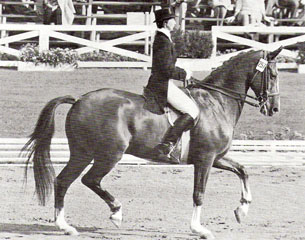 Ulla persevered and succeeded in such a way that made Wikne, once an Olympic dressage rider himself, regret his discouraging advise he had given. Five years later he confessed: “How nice to be proved wrong.”
Ulla persevered and succeeded in such a way that made Wikne, once an Olympic dressage rider himself, regret his discouraging advise he had given. Five years later he confessed: “How nice to be proved wrong.”
Ajax reached Grand Prix level within two years and even more: He returned to Aachen in 1970 as member of the 4th placed Swedish dressage team and in 1971 he won the most prestigious Grand Prix of Aachen against all Germans and all “odds”. The same year the Swedish team won team bronze at the European Championships in Wolfsburg and thanks to Ajax they could repeat this feat a year later at the 1972 Olympic Games in Munich.
Though only having started his international dressage career at the progressed age of 13 Ajax continued to be among the best dressage horses in the world until 1976 when he was already 19 years of age. He flew to the Olympic Games in Montréal but the faithful horse died there because of an undiscovered kidney tumor. “It had been my darkest hour as a rider until today.”
Surprisingly Ulla still hoped to continue her interrupted career as a jumping rider. Despite popular belief, Hakanson never was a professional rider and never had many horses at home to build on. “After the high school I always used to work as a secretary, preferably for half a day to concentrate on my horses in the afternoon. Unfortunately it wasn’t always possible and the more I had to work in the office the less time I had for the horses,” Ulla told Eurodressage.
Elymus, Flyinge Flamingo and Cesam
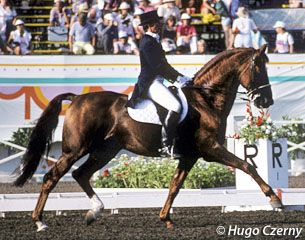 So after Ajax’ death Ulla had no dressage successor but she hoped to have a good jumper in a Swedish gelding called Elymus and continue her interrupted show jumping career with him. Like Ajax he had been sired by Jovial and was bred by the same breeder. Until 1974 she jumped the 1969 born gelding with quite some success, but it became obvious he wouldn’t excel at the highest levels and so Ulla switched to dressage again, training Elymus up to Grand Prix. She started him in the 1978 World Championships as well as the European Championships the following year, but not with the same success she had enjoyed with Ajax, though Elymus ranked a respectable 9th in 1979. The early depart of Elymus interrupted Ulla’s career again.
So after Ajax’ death Ulla had no dressage successor but she hoped to have a good jumper in a Swedish gelding called Elymus and continue her interrupted show jumping career with him. Like Ajax he had been sired by Jovial and was bred by the same breeder. Until 1974 she jumped the 1969 born gelding with quite some success, but it became obvious he wouldn’t excel at the highest levels and so Ulla switched to dressage again, training Elymus up to Grand Prix. She started him in the 1978 World Championships as well as the European Championships the following year, but not with the same success she had enjoyed with Ajax, though Elymus ranked a respectable 9th in 1979. The early depart of Elymus interrupted Ulla’s career again.
In 1982 she had only the 5-year old Cesam when the Swedish dressage riders were invited to visit the Swedish National Stud Flyinge and were allowed to ride some of their stallions. ”One of those was a chestnut called Flyinge Flamingo by Urbino. As you know Urbino was also the sire of my later horses Tolstoy and Bobby and I like his offspring very much. So Flamingo suited me very well and I was able to ‘borrow’ him from Flyinge for about 5 years,” Ulla reported.
Flamingo was a beautiful and impressive stallion with an intense chestnut colour and with the typical stallion topline. His dam was by Ajax’ and Elymus’ sire Jovial and so he carried valuable Swedish blood on both sides. Flamingo’s daughter Flamkella became famous being the dam of Flyinge Amiral, Kyra Kyrklund’s and Pether Markne’s Olympic dressage horse. When Ulla took him over in 1982 he was already 13 years of age, but only at L-level in dressage.
“I had to bring him to the higher levels. And though he was a willing learner he lacked all his life the basic work that every young horse should get. This was the reason why his hind legs never carried as much as they should have done and he lacked enough sit in the piaffe."
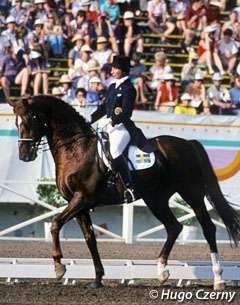 However it was that charming stallion which brought Ulla back on the international scene and back in the Olympic medal rankings. Rather surprisingly Sweden took the second bronze medal in Los Angeles 1984 twelve years after Munich again with Ulla was on the team. Flamingo enabled her some other nice achievements such as winning the freestyle class at the 1986 World Championships in Cedar Valley when he was already 17 years old.
However it was that charming stallion which brought Ulla back on the international scene and back in the Olympic medal rankings. Rather surprisingly Sweden took the second bronze medal in Los Angeles 1984 twelve years after Munich again with Ulla was on the team. Flamingo enabled her some other nice achievements such as winning the freestyle class at the 1986 World Championships in Cedar Valley when he was already 17 years old.
After his retirement from the sport Flamingo influenced Swedish warmblood breeding by producing talented horses, among them Robert Dover’s Juvel anr Samuel Schatzmann’s 1988 Olympic team silver-medalist Rochus with whom Flamingo contested at the 1986 World Championships.
Ulla never bought ready-made horses, but instead always purchased them as four or five year olds, often directly from their breeders in Sweden. It was no different with her 3rd Olympic horse, the dark brown gelding Cesam. “Cesam I bought as a 4-year old from my neighbour who had bred him. He is by Ceylon, who was also sire to Ann-Katrin Linsenhoff’s Courage or Kyra’s Master. At 4 he was okay to handle, but turning 5 he began to become a very difficult horse. He loved to rear and after two years of a fight I told him once that if he doesn’t stop I take him to Helsingborg to get him castrated. Funnily from that day on he behaved.”
Ulla considers Cesam to be the most difficult horse of her entire life because he was also quite stubborn, but in the end she succeeded in upgrading him to Grand Prix level. At the 1987 European Championships they had been the team’s drop score, but only a year later Cesam was best horse, placing 25th out of 70 starters, on a disappointing Swedish team that finished in last place at the 1988 Olympic Games in Seoul.
The Flyinge boys: Tolstoy and Bobby
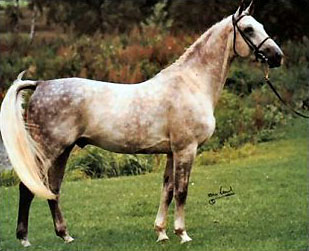 Following her principle to buy only young horses she could train herself in the way she preferred, Ulla found a promising young stallion in the mid 1980s at the national stud in Flyinge. Flyinge Tolstoy, a licensed grey son of Urbino and born in 1982, actually hadn’t been for sale when Ulla came to Flyinge looking to buy a youngster. “I looked at some youngsters, but none of them convinced me. Then Jan Jönsson entered the indoor arena with Tolstoy and I immediately liked him. I liked his abilities and of course his pedigree as I liked riding Urbinos.”
Following her principle to buy only young horses she could train herself in the way she preferred, Ulla found a promising young stallion in the mid 1980s at the national stud in Flyinge. Flyinge Tolstoy, a licensed grey son of Urbino and born in 1982, actually hadn’t been for sale when Ulla came to Flyinge looking to buy a youngster. “I looked at some youngsters, but none of them convinced me. Then Jan Jönsson entered the indoor arena with Tolstoy and I immediately liked him. I liked his abilities and of course his pedigree as I liked riding Urbinos.”
In the end Flyinge agreed to sell their promising young breeding stallion and Tolstoy developed into one of Ulla’s steadiest and most successful horses. The grey had a beautiful head with big dark eyes and was a charming appearance. At his first international championships -- the 1993 Europeans in Lipica and the 1994 WEG in The Hague -- he immediately reached the kur finals and placed 8th on both occasions. He also attended the 1995 European Championships and had thrilled the crowds on home turf during the World Cup final in Gothenburg a year earlier.
While Tolstoy was still in his prime Ulla was in the enviable position to own a second, equally good, if not better stallion: Bobby. This very elegant and clearly blood influenced Swedish warmblood took over from Tolstoy in 1996, remaining a member of the Swedish teams for 6 years in a row.
”Bobby, another Urbino, I bought after the auction at the 1990 WEG in Stockholm when he was 4 years old. He was very tired after all the preparations, but I thought that with his bloodlines he shouldn’t remain tired for long. I took on the chance and was right. Bobby was a good purchase,” Ulla remembered.
With the horse being very successful internationally Flyinge Stud became interested in distributing the stallion’s semen and so a co-operation was formed: “They distributed his semen and Bobby got the forename “Flyinge” in return as long as he was listed as one of their stallions.”
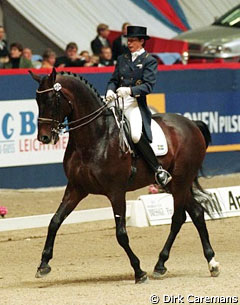 Bobby attended three European Championships, the 1998 WEG in Rome and the Olympic Games in 1996 and 2000, thereby winning two team bronze medals.
Bobby attended three European Championships, the 1998 WEG in Rome and the Olympic Games in 1996 and 2000, thereby winning two team bronze medals.
Unfortunately Ulla will not only remember the horse as one of her best, but also the one with whom she had to face one of her greatest disappointments in the sport: “We prepared the horse for the Sydney Olympics for months, we had 4 weeks of quarantine prior to the departure, Bobby had this very long flight to Australia and of course we wanted to do well there. But then, just minutes before it was our turn in the Grand Prix, he became irregular in the warm- up ring. Our vet examined Bobby and strongly advised me to withdraw him otherwise more serious damage would be done. It really was a blow—so much work for nothing!”
The two stallions had been similarly successful, both competed alongside and both left Ulla’s life within three months time in 2007, suffering from fatal colic attacks.
Ulla had ridden the boys regularly until their last days and as always after such a long intensive time together the loss was enormous: “It had been like losing a dear friend after being together for such a long time.”
Unfortunately Ulla couldn’t manage to find a proper offspring neither by Tolstoy nor by Bobby to continue her tradition riding Urbino get.
Back in the Big Time: Richelle
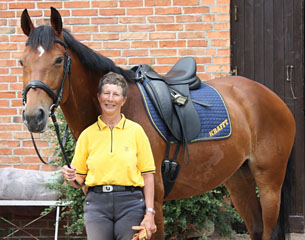 Ulla never completely stopped competing, but after the retirement of Tolstoy and Bobby she was left without a Grand Prix horse that was exceptional enough to join the national team. The Danish gelding Lidro, now 18 and still being ridden daily, was competed nationally at Grand Prix level. “I started him a lot at GP level over the past years, but he is lacking exceptional talent. My groom who takes care of our four horses is allowed to ride him two times a week when I teach her”.
Ulla never completely stopped competing, but after the retirement of Tolstoy and Bobby she was left without a Grand Prix horse that was exceptional enough to join the national team. The Danish gelding Lidro, now 18 and still being ridden daily, was competed nationally at Grand Prix level. “I started him a lot at GP level over the past years, but he is lacking exceptional talent. My groom who takes care of our four horses is allowed to ride him two times a week when I teach her”.
Ulla and her husband Arne each have two horses of their own. The horses are stabled at their small private farm at the edge of the woods, 15 kilometres from Kristianstad in South Sweden. “After our horses had been stabled at the military at the beginning we bought this property more than 30 years ago, shortly after Montréal. We have a stable with 7 boxes, an outdoor arena and a shed where we store the roughage. We also have several bigger paddocks for the horses to be turned- out.”
In 2009 Ulla was looking for an addition to the ageing Lidro and the Rüben family knew that. When Ulla visited the CDIO Aachen Susanne Rüben told her that they had a mare in her Aachen based stable which could suit her. “First I was sceptical because I didn’t want to have a mare. I never had one for dressage because I always had stallions in my stable,” Ulla reported.
This mare was the then 10 year old Rhinelander bay Richelle (by Rivero II out of a Darlington dam). Susanne Rüben had already started her at national Grand Prix with considerable success, but the horse was quite inexperienced as she first had had two foals and only started working seriously at 7.
Ulla tried her and admitted she liked Richelle straight away: “I had a very good feeling on her. She was very well trained and her quality is without question. Moreover, and this is very important when buying such horses, I know the Rübens for a long time and I have complete faith in them.” Ulla returned in September 2009 for three more days to try out Richelle and after that decided to buy her.
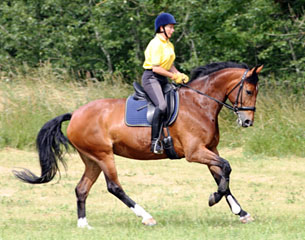 Once in Sweden the mare, which tends to be a bit hot sometimes, had got used to different training. “I almost always train outside and in every weather condition because we only have a small indoor arena of 15 x 25 m. Only when we have ice like now I train indoors. Very often I ride in the forests. We have a sandy soil here so I can exercise canter pirouettes around trees for example. It works really well! Moreover my experience taught me that it is very good for horses to move on different surfaces. Richelle wasn’t used to be ridden outside and was very spooky at the beginning. But because she is such a lovely character she doesn’t react by running away or doing something dangerous. In particular she was afraid of trees and stones. In an arena or at competitions she is much quieter.”
Once in Sweden the mare, which tends to be a bit hot sometimes, had got used to different training. “I almost always train outside and in every weather condition because we only have a small indoor arena of 15 x 25 m. Only when we have ice like now I train indoors. Very often I ride in the forests. We have a sandy soil here so I can exercise canter pirouettes around trees for example. It works really well! Moreover my experience taught me that it is very good for horses to move on different surfaces. Richelle wasn’t used to be ridden outside and was very spooky at the beginning. But because she is such a lovely character she doesn’t react by running away or doing something dangerous. In particular she was afraid of trees and stones. In an arena or at competitions she is much quieter.”
Ulla likes cantering her horses a lot on the snow covered field around her property. “I canter the horses outside, work them over cavalettis or jump them over smaller fences so they do something differently to dressage training. It’s amusing for them,” emphasised Ulla.
A usual day for her starts at 9 am. First Lidro is ridden in the forests, accompanied by Ulla’s German shepherd, then he is worked on the field outside at the end of the hack. Afterwards it’s Richelle’s turn who also starts with a hack and then is worked in the fields and sometimes in the outdoor arena: “I prefer training the horses in the fields and I think it’s nicer for them too." In the afternoon the horses are turned out separately in their paddocks; for how long depends on the weather conditions.
”Currently, as it is very cold, we only turn them out for about 2 hours. In the summer, if the flies are not too bothering, they are outside the whole afternoon. I always put boots on the horses’ legs to protect them from injuries. Also I cannot turn them out together because they all have shoes at their hind legs and the risk of an injury is very high.”
Every five weeks a physiotherapist comes and treats Ulla’s horses as well as their rider.
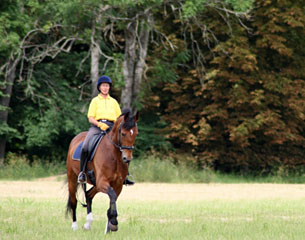 Richelle has further progressed since her arrival at her new home more than a year ago. Ulla trains regularly with former Olympic dressage rider Eva-Karin Oscarsson and they try to improve the individual exercises even more. “Richelle has very good movements, particular her trot is of high quality and she is very nice to ride. She always wants to go forward and please," Ulla said in praise of her new acquisition.
Richelle has further progressed since her arrival at her new home more than a year ago. Ulla trains regularly with former Olympic dressage rider Eva-Karin Oscarsson and they try to improve the individual exercises even more. “Richelle has very good movements, particular her trot is of high quality and she is very nice to ride. She always wants to go forward and please," Ulla said in praise of her new acquisition.
After a few very successful starts at Intermediaire II and Grand Prix in Sweden last summer, Ulla competed at the Swedish Championships in Strömsholm in late August 2010. There the mare won the Inter II- test and placed a very good 4th in the Grand Prix behind the three riders nominated for the WEG in Kentucky. She finished 5th in the freestyle and finished 5th overall which was an outstanding result for such a new combination.
Both went on and debuted at CDI-level together at Oslo in mid-October. Richelle was third in the Inter II, 6th in the Grand Prix and 4th in the freestyle with over 68%.
Not a bad beginning on the international scene for sure!
It seems like Ulla has found a diamond in the autumn of her long career and why not finish it with a start in London 2012 which would be her 7th Olympic Games, just 40 years after her Olympic debut.
Ulla on…
…her greatest success: “Ajax in general, that I succeeded in making such a good dressage horse of him and in particular the Olympic Games 1972 where I won the bronze medal and placed 6th individual on my former jumping horse.”
…her greatest disappointment: “Ajax untimely and unexpected death at Bromont 1976 and of course Bobby becoming lame just minutes before having the Olympic Grand Prix 2000. Such a long journey for nothing!”
…buying a young horse: “I always bought youngsters, but now it doesn’t make sense with me being 73. When I bought youngsters I looked for their movements, but also paid attention that they are clear in their mind. I like looking at their eyes, it says much. Also they have to be eager to work.”
…the Swedish breeding: “In the past it been much easier to find a good Swedish horse. I think the good Swedish breed has been forgotten. Now always the foreign breeds are the best. Of course Sweden has to sell good horses, but we should continue using our good old bloodlines.”
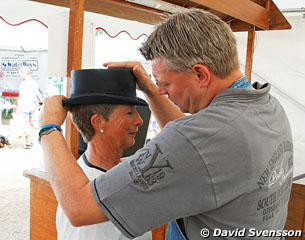 …dressage of today:” Today the horses are very often more beautiful, more noble and more “electrical”. This is good for a rider who is able to train these horses. Unfortunately we are lacking such riders who are able to train a horse properly. Also for riding schools or beginners the modern type of horse isn’t easy to handle.”
…dressage of today:” Today the horses are very often more beautiful, more noble and more “electrical”. This is good for a rider who is able to train these horses. Unfortunately we are lacking such riders who are able to train a horse properly. Also for riding schools or beginners the modern type of horse isn’t easy to handle.”
…The “Ajax Fund”: “In 2005 I started paying the sport something back. 15 young hopefuls not older than 30 have got the stipendium so far. They get 200,000 Swedish crowns, private money, for training purposes. Usually I chose dressage riders, of course, but also two young jumping riders, Ann-Sofie Oscarsson and Alexander Zettermann, have got it.”
…London 2012: “I can think about that, but you never know what will happen at an age like mine.”
…competing at her age: “I want to have a goal and I still enjoy the shows. If one still feels fit enough one should go for it. Concerning team selection the best riders should compete. Age shouldn’t be a decisive factor and having experience is never wrong.”
Article by Silke Rottermann for Eurodressage.com
Photos: Hugo Czerny - Dirk Caremans - private courtesy Hakanson - David Svensson
Related Links
Greatest Oldies: Ajax, a Swedish Legend
Ulla Håkanson Pays It Forward with "Ajax Fund"
Ulla Hakanson's Flyinge Bobby Retired
Ulla Håkanson's Flyinge Bobby Passed Away
Flyinge Tolstoy Passed Away
Mia von Essen, First Recipient of Ajax Stipend
Larsson, Mattisson, Karlsson Win Ajax Stipend